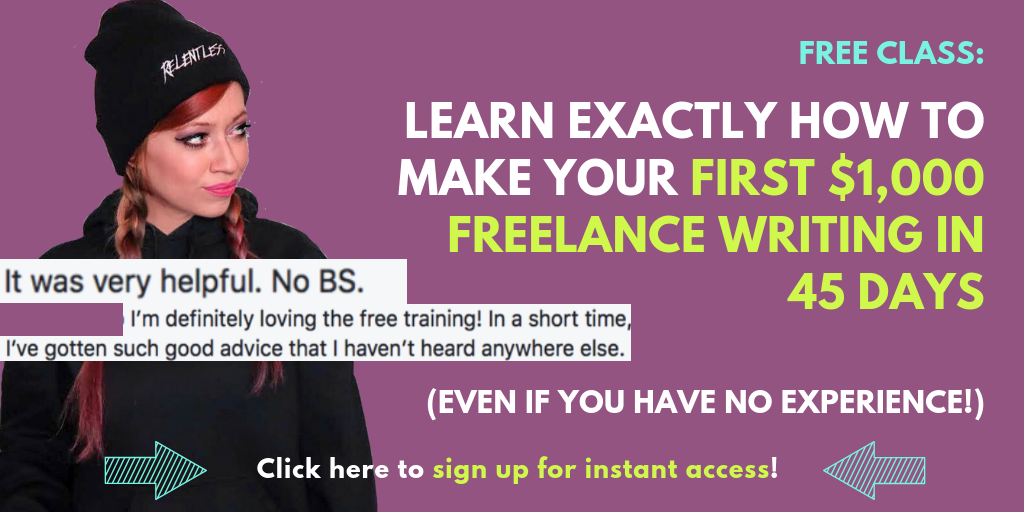Hi friends! Jorden here, and I’m SUPER excited to share another guest post with you allllllll about the BEST education writing jobs for teachers. If you’re an educator and/or specialize in the education niche, get excited, because you’re about to find detailed information about 13 sites that pay $100+ each! If you enjoy the post, please show some love to the talented author, Tiffany Hathorn, by sharing the post on social media (you can hover over and Pin the image above!). 🙂 Let’s jump in!
Are you a teacher who needs to earn more income?
Or an education writer looking for your next writing gig?
Freelance writing can be a fantastic way to share your skills and knowledge – and get paid for it!
Whether you need to pad your bank account during school breaks or need a significant stream of income to support your family, we’ve done the footwork to get you started!
Below, you’ll find 13 education writing jobs that pay $100+.
For each publication, you’ll find information on what kind of content they look for, submission guidelines, and how much they pay.
(And I’ve included both online and print publications to offer more variety!)
Be sure to read all the way to the end, where you’ll find a few solid tips on pitching publications successfully so that you get more “yes” responses!
Education Writing Jobs For Teachers: 13 Sites That Pay $100+ Per Article
1. American Educator
The American Federation of Teachers publishes this professional magazine on a quarterly basis.
Topics of Interest
They’re seeking articles on a variety of topics, including (but not limited to):
- New Educational Trends
- Current Issues in Education
- Education Law
- Professional Ethics
- Current American Social Issues
- International Affairs and Labor Issues Relevant to Teachers
Writer Guidelines
Articles should be well-researched, but written for a general audience. No technical jargon!
Personal narratives should be short, concise, and relevant to the time of publication.
Article length may vary from 1,000 – 5,000 words, depending on the topic, and should adhere to Chicago Manual of Style.
Queries are preferred and should be sent to ae@aft.org. Visit their website for more info on article submission guidelines.
Pay
Payment varies based on length, but the minimum payment is $300. Writers are paid upon publication.
2. Arts and Activities Magazine
Arts and Activities Magazine is available in both print and online formats.
They provide teachers with resources, information, ideas, and inspiration to spark creative visual expressions in student from kindergarten through high school.
This magazine is also used by students in teacher education programs in colleges and universities all over the world!
Topics of Interest
They’re seeking content that focus on art education topics, including (but not limited to):
- Art and Creative Expression activities
- Ways to relate art to other disciplines (especially STEM subjects)
- Mixed Media lessons
- Forms of art like digital art, weaving, photography, 3D design, etc.
- Classroom management tips
- Lesson plans and projects for substitutes
Writer Guidelines
Articles should be 600 – 1,000 words. Before writing, make sure you get to know their formatting style by checking out past issues here.
Submit pitches to ed@artsandactivities.com.
View the full writer guidelines here.
Pay
Pay ranges between $35-$150, depending on length. Payment is made upon publication.
3. Aurora Magazine
Published by the University of Alaska Fairbanks, this biannual magazine alumni and friends of the university in mind.
Topics of Interest
According to the university website, the goal of the magazine is to elicit emotions and provoke thought.
To get a feel for the type of content that might appeal to Aurora readers, check out the magazine’s online archives, where you can view issues from the past decade.
Writer Guidelines
Manuscripts should be submitted for consideration to ksdavis@alaska.edu. Be sure to adhere strictly to the submission guidelines.
Pay
Pay is 50 cents per word, which could come out to $100 (or much more!) depending on the length of your work.
Be aware, though, that you are only paid for the word count you are assigned.
If the scope of the project looks like it needs to be adjusted, you should reach out to the features editor as soon as possible!
4. Metro Magazine
Published by the Australian Teachers of Media (ATOM), Metro Magazine is Australia’s oldest film and media periodical.
The focus is on generating discussion surrounding film and media in not just Australia, but New Zealand, and Asia.
Topics of Interest
They specialize in essays, articles and interviews on Australian, New Zealand and Asian film and media – including television, radio, animation, games and new media.
…If you’re a teacher in any of those industries, this could be the perfect opportunity for you!
Writer Guidelines
Submissions, pitches, and edits should all be submitted to Adolfo Aranjuez at metro@atom.org.au. Full submission guidelines can be found on their website.
Pay
Pay ranges from $80-$350 AUD which is between $52-$242 USD. Pay is made upon publication.
5. Mizzou

The magazine of the University of Missouri Alumni Association, Mizzou discusses issues that face people in the community and around the world.
Topics of Interest
Some of the topics that they are looking for revolve around human interest, food, health, and the environment.
Writer Guidelines
Submissions can be emailed to interim editor, Dale Smith at smithdal@missouri.edu. Learn more about submission guidelines on their website.
Pay
Fees are negotiated on an individual basis, so put your best foot forward when pitching and be prepared to show your value when sharing your rate.
Payment is made upon acceptance of the completed manuscript.
6. Notre Dame Magazine
Published by the prestigious University of Notre Dame, this quarterly magazine has a readership over over a quarter million people.
Topics of Interest
Notre Dame Magazine is composed of four departments: Campus News, Alumni Notes, Features, and CrossCurrents.
Freelancers create the majority of the content for the latter two departments.
CrossCurrents
The CrossCurrents essays are meant to appeal to “college-educated readers who take an active interest in the contemporary world (art, science, religion society, etc).
Generally written from the 1st-person point of view, these 750-1,500 word pieces can be topical or personal, with tones ranging from light-hearted to serious.
Features
Features stories are a bit longer (2,000 to 4,000 words), but they’re also written with college-educated people who care about contemporary issues in mind.
Web Exclusives
The magazine also accepts pitches to be published exclusively online.
These web exclusives fall under three categories: personal essays (written in a style similar to CrossCurrents), short stories that highlight an aspect of the Notre Dame experience, and pieces that revolve around one of their recurring web series.
Writer Guidelines
Before you pitch or submit a story, it is recommended that you become familiar with their publications. You can view past issues of Notre Dame Magazine here.
Depending on the department and format, you will be required to submit either a query letter (with published clips) OR a completed article/essay.
To learn about their full submission guidelines, please visit their website.
Pay
Payment is $250 – $300, depending on length.
7. Screen Education Magazine
Another ATOM publication, Screen Education Magazine is written by and for primary and secondary teachers and students.
Topics of Interest
They are seeking articles centered on screen literacy in education. They also accept pitches for practical classroom ideas, lesson plans, essays, study guides, updates on new technology, and book/DVD reviews.
Writer Guidelines
Submissions, pitches, and edits should all be submitted to David Heslin at screen_ed@atom.org.au.
Full submission guidelines can be found on their website.
Pay
Pay ranges from $150-$200 AUD which is between $103-$138 USD. Pay is made upon publication.
8. Teachers & Writers Magazine
If you teach about writing, this could be the perfect opportunity for you!
Topics of Interest
Teachers & Writers Magazine has its focus on teaching students of all ages (from kindergarten through college) how to write.
Their online magazine presents a variety of ideas, approaches, and explorations on teaching students to put their imagination into words.
They look for both practical theoretical pieces that are “vivid, concise, and geared toward a general audience”.
The magazine is composed of 4 sections. 3 of these sections are open to submissions from freelance writers. They’re:
The Art of Teaching Writing
This section includes articles, essays, editorials, and meditations. Some of the topics include current issues in arts education, literary arts advocacy, as well as the joys and challenges of teaching creative writing (regardless of the setting).
Pieces in this section are 1,000 – 2,500 words.
Lesson Plans
If you have experience with lesson planning or curriculum development, they also look for innovative lessons or ideas revolved around teaching creative writing.
Lessons should be so detailed that teachers should be able to teach the full lesson without needing to turn to outside sources. Lesson plans range from 500 – 2,500 words.
Interviews
If you have connections in the literary world, use them! They’re looking for interviews with poets, novelists, nonfiction writers, and playwrights who are willing to discuss their work, the craft of writing, as well as their personal views on the field of creative writing education.
They also value interviews from individuals in other fields who have strong opinions on the impact of art in our lives and the value of arts education. Interviews should be 1,500-3,000 words.
Writer Guidelines
Interested writers should submit a brief (500 words max) email inquiry describing the proposed piece.
If you have a completed article to submit, make sure that it meets the word count guidelines above.
Queries and submissions should be sent to editors@twc.org. Visit their website for full submission guidelines.
Pay
Pay ranges from $50 – $250 with lesson plans being on the lower end. You are paid upon publication and also receive copies of the magazine. There is no kill fee.

SIDE NOTE: if you want to learn how to make your first $1,000 freelance writing with no experience, click here to take my FREE class. it’s been enjoyed by over 6,000 writers, and when you sign up, you get instant access so you can start learning right away. 🙂
9. Texas Homeschool Coalition Review
The Texas Homeschool Coalition’s mission is to inform, inspire, promote, protect, and advocate for homeschooling and homeschool families in Texas.
The Texas Homeschool Coalition Review is published quarterly (in February, May, August, and November).
Topics of Interest
They’re seeking relatable, shareable content in the following categories:
New to Homeschooling
Anything that will help people who are interested in or new to homeschooling.
This includes info on learning styles, curriculum options, book reviews, homeschool schedules, tips on teaching multiple children, tips on teaching only children, etc.
Extracurricular Activities
Articles on the extracurricular and socialization aspects of homeschool, including co-ops, field trips, sports, music, educational vacations, and DIY projects.
New to Texas
Tips and resources for people who are new to Texas, including places to visit, support groups, and staying in contact with loved ones.
Special Needs
Articles that provide support, encouragement and resources for homeschool families that deal with special needs, such as autism, Down Syndrome, dyslexia, ADD/ADHD, etc.
This can include activities, curriculum options, learning styles, extracurriculars, coping tools, and more.
Dads and Homeschooling
Articles centered on how dads can be actively involved in the homeschool process.
The Elementary, Middle, and High School Years
These topics should be tailored to fit each level and can focus on things such as curriculum options, co-ops, activities, socialization, and dual-credit.
Encouragement
Articles on finding support, collaborating with other families, making homeschool work, getting organized, and more.
Academics
This should focus on specific tips and resources for various subjects such as math, science, reading, writing, grammar, history, foreign language, and more.
This is also where you can share product reviews.
Writer Guidelines
Articles should be between 650-1,250 words.
Pitch your ideas to publications@thsc.org. Be sure to include a brief bio and links to your blog.
Visit their website for more info on writing opportunities.
Pay
Pay is $100 per article.
10. Teaching Tolerance Magazine

Teaching Tolerance Magazine is focused on helping teachers and school educate students on being active members in our democracy, with a focus on social justice and anti-bias.
Topics of Interest
They are accepting manuscripts and pitches for feature stories that revolve around social justice and anti-bias education, personal reflections about life in the classroom, short stories, and articles that addressing teaching and education issues.
Writer Guidelines
Submissions should be sent to submissions@tolerance.org with “TT Magazine Article” in the subject line. For full instructions, visit their writer guidelines page.
Pay
Pay ranges from $150 for short articles to $1 per word for features and short stories.
11. The School Magazine
The School Magazine is a bit different than the education writing jobs mentioned so far.
Rather than being written for educators or parents, the readers of this Australia-based magazine are children. Specifically, children between the ages of 8 and 12 years of age.
Topics of Interest
In addition to having a call for specific topics (which will be announced around June of 2019 for 2020 issues), they are also looking for fiction, articles, nonfiction interviews, poetry, plays, and text activities.
Writer Guidelines
You should submit full manuscripts tp submissions.tsm@det.nsw.edu.au. They require non-exclusive, ongoing print and digital rights, as well as first rights to publish. However, writers retain copyright of their work. They also pay a repeat fee if they decide to reuse your article in the print version of their magazine. Go here to read full submission guidelines.
Pay
Pay is stated to be 300 Australian Dollars (AUD), which is about $207 USD. They pay upon publication.
12. Today’s Catholic Teacher
Today’s Catholic Teacher is a seasonal print publication is aimed at K-8 educators, specifically those who teach in private and Catholic schools.
School staff, boards of education, religious leaders, and parents also read this magazine regularly.
Topics of Interest
They accept submission ideas that are geared towards Catholic school education. They have a specific interest in the following topics:
- Issues surrounding curriculum development, resting, technology, school relationships, creative teaching, community needs, and school administration.
- National issues and trends that impact the catholic school system
- Subject-specific teaching ideas
Writer Guidelines
Send detailed queries to editor@catholicteacher.com. Full submission guidelines can be found on their website.
Pay
Writers are paid $300 upon publication.
13. Women in Higher Education
Women in Higher Education is a monthly newsletter designed to teach women on college campuses (and beyond) with insight and practical ideas for successfully navigating the male-dominated world of higher education.
The vast majority of readers are faculty.
Topics of Interest
The topics that readers are most interested in include:
- Advice from successful women on campus
- Communication techniques
- Leadership
- Career strategies
- Ethical values
- Using intuition
- Research on gender differences
- Mentors and role models
- Problems facing women chairs
- Ending sexual harassment.
The publication departments are:
- In Her Own Words – research results, personal essays and subjective insights on relevant topics
- Moveable Type – synopsis of a useful book
- Interview – profile a woman leader in higher education
- Features -new programs, speeches, major research of interest
Writer Guidelines
Email pitches or queries to editor, Kelly Baker at kjbaker@wiley.com. Visit their website for full submission guidelines.
Pay
Accepted guest contributors are paid $150 per piece.
How to Find More Education Writing Jobs to Pitch
This list is not exhaustive. You can find tons of other publications that offer education writing jobs.
In fact, every week, there may be even more publications launching that might love to outsource content creation!
So, where does that leave you?
…With a ton of opportunity!
Chances are, if education is your niche or passion, you read a LOT of content on the subject.
Websites, magazines, books, blogs, etc.
Each and every publication you read might be an untapped source of income – even if they don’t have writer guidelines listed on their site!
So, I recommend you make a habit of seeking opportunities to write for publications you admire.
Always check their website and the inside cover of magazines to find out if they are actively seeking writers. If so, pitch them!
If they DON’T have readily available info on how to pitch them, that doesn’t mean that they aren’t interested.
You just have to show them the value that you offer.
Then, let them decide whether it’s something they feel they could benefit from.
Which brings us to the next big thing – how to pitch publications.
Tips for Successfully Pitching These Education Writing Jobs for Teachers

Whether you are using a submission guideline or cold pitching a publication, there are a few best practices to follow.
Tip #1: Follow Directions
If you are following submission guidelines provided by the company – follow them!
Don’t just wing it and hope for the best.
Listen to what they want and then do things exactly as they’ve said.
More than likely, you’re not the only person pitching ideas.
You may not even be the only person pitching YOUR idea.
So, if they have to choose between someone who ignored a clear set of rules and someone who made their lives easier by following the rules, guess who they’re going to choose?
It’s one thing to break the mold and show your creativity.
But do so within the guidelines that make the process smooth for the people making the decision to give you a chance!
Tip #2: Do Your Research
Some people may think that pitching is all about numbers.
Yes, the more you pitch, the higher your chances are of getting work.
BUT, if you think that just pitching publications all willy nilly is going to work, you are sadly mistaken.
Let’s pretend that one person spent an hour using a basic pitch template and sent it to 30 publications.
Now, let’s imagine that another person spends an hour pitching 5 publications that she has read a few times.
The person who sent out mass pitches to 30 publications will be lucky to land a good-paying gig whereas the person who sent out 5 thoughtful pitches to publications she was familiar with might end up getting multiple yes’s.
So, the lesson here is to read the publications you want to write for.
Pay attention to the content they publish, their writing style, and the tone they use.
You will need all of that information to craft a pitch that is more likely to result in income (and a better writing portfolio).
Tip #3: No Fluff!
If you are prone to rambling, you need to break that habit.
Be clear and to-the-point.
Always.
Whether pitching or writing.
I hope that this list of education publications helps you on your path to make money writing from home on a topic you love!
Now here’s what I want you to do:
Pick one of the education writing jobs in this blog post (or another that you find!), and pitch them THIS WEEK.
Then, share this post on social media to spread the love to your fellow educators!
Author Bio: Tiffany Hathorn divides her time between being a launch copywriter, homeschooling her son, performing in dinner theater, and being an unapologetic geek (Potterhead forever!). She lives in Central Arkansas with her son and 3 pets – Neville, Bruno, and Berlioz. You can find her on her website. Check out her article, 17 Ways to Overcome Writer’s Block.

